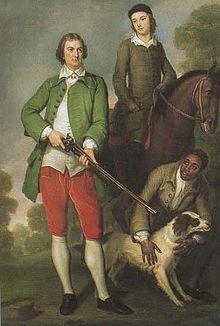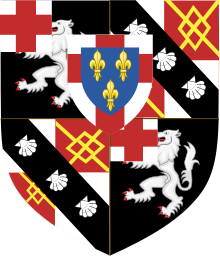Spencer family
From the 16th century, its members have held numerous titles, including the dukedom of Marlborough, the earldoms of Sunderland and Spencer, and the Churchill barony.Round argued that the Despencer descent was fabricated by Richard Lee, a corrupt Clarencieux King of Arms.[1] Citing Round, The Complete Peerage dismissed the alleged Despencer descent as an "elaborate imposture" which "is now incapable of deceiving the most credulous.His nephew, Sir John Spencer (died 1522), first made a living by trading in livestock and other commodities and eventually saved enough money to purchase both the Wormleighton and Althorp lands.[6] In 1519, he was knighted by King Henry VIII, died three years later and was buried in the new family chapel at Great Brington.Sheep from their pastures were purchased for breeding and it is probable that the family's success as farmers was rarely equalled in the century.The younger son, Robert (1629–1694), sat in the House of Commons from 1660 to 1679 and was created Viscount Teviot in the Peerage of Scotland in 1685.In 1902, his grandson, the 3rd Baron, was created Viscount Churchill, of Rolleston in the County of Leicester, also in the Peerage of the United Kingdom.The 2nd Earl's youngest son George (1799–1864) converted from Anglicanism to the Roman Catholic Church, became a priest and took the name of Father Ignatius of St Paul.He was succeeded in 1910 by his half-brother, the 6th Earl Spencer, who had been made Viscount Althorp, of Great Brington in the County of Northamptonshire, in the Peerage of the United Kingdom, in 1905 and served as Lord Chamberlain from 1905 to 1912.








Spencer (surname)Noble familyEnglandSir John SpencerJames Spencer-Churchill, 12th Duke of MarlboroughBlenheim PalacePrincess of WalesDuke of MarlboroughEarl of SunderlandEarl SpencerViscount ChurchillViscount AlthorpBaron Spencer of WormleightonPrime Minister of the United KingdomSir Winston ChurchillDiana, Princess of WalesBritish royal familyChurchill familyCavendish familyFrenchAlthorpSpencer HouseWormleighton ManorSpencers of Althorparistocraticdukedom of MarlboroughSunderlandSpencerChurchill baronycadet branchLe DespencerJ. Horace RoundClarencieux King of ArmsThe Complete PeeragefeoffeeWarwickshireNorthamptonshireLittle BringtonGreat BringtonSt Mary the VirginThomas Grey, 2nd Marquess of DorsetKing Henry VIIIKnight of the ShireSir Robert SpencerBrackleyKnight of the GarterPeerage of EnglandKing James IHowardsFitzAlanEarls of ArundelRobert Spencer, 1st Baron SpencerWilliamRobertHouse of CommonsViscount TeviotJamie Spencer-Churchill, 12th Duke of MarlboroughCharles Spencer, 9th Earl SpencerRobert Spencer, 2nd Earl of SunderlandLord President of the CouncilCharles, 3rd Earl of SunderlandLord-Lieutenant of IrelandLord Privy SealFirst Lord of the TreasuryLady Anne ChurchillJohn Churchill, 1st Duke of MarlboroughHenriettaCharlesWormleightonBedfordshireFrancis SpencerGeorge Spencer, 4th Duke of MarlboroughBaron ChurchillWychwoodCounty of Oxford3rd BaronCounty of LeicesterPeerage of the United KingdomGeorge Spencer, 5th Duke of Marlboroughsurnamecoat of armsdouble-barrelled surnameBritish prime ministerClementinelife peeressWoodstockOxfordshireSt Martin's Church, BladonJohn Spencer, 1st Earl SpencerThomas GainsboroughJohn Spencer3rd Earl of SunderlandPeerage of Great BritainKing George IIIMargaret Poyntz2nd Earl SpencerHome Secretary3rd Earl SpencerChancellor of the ExchequerLord GreyLord MelbourneGeorgeAnglicanismRoman Catholicmissionarybeatification4th Earl SpencerRoyal NavyNapoleonic WarsGreek War of IndependenceVice-Admiral5th Earl SpencerWilliam Ewart GladstoneLord Lieutenant of Ireland6th Earl SpencerLord Chamberlain7th Earl Spencer8th Earl SpencerFrances Ruth Rochemarried Prince CharlesSt Mary the Virgin Church, Great BringtonNorth CreakeNorfolk2nd Duchess of Marlborough3rd Duke of MarlboroughSir John Spencer, Kt.
